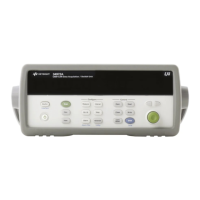7Tutorial
304 Keysight 34970A/34972A User’s Guide
Resistance Measurements
An ohmmeter measures the DC resistance of a device or circuit connected to its
input. Resistance measurements are performed by supplying a known DC current
to an unknown resistance and measuring the DC voltage drop.
The internal DMM offers two methods for measuring resistance: 2-wire and 4-wire
ohms. For both methods, the test current flows from the input HI terminal through
the resistor being measured. For 2-wire ohms, the voltage drop across the resistor
being measured is sensed internal to the DMM. Therefore, test lead resistance is
also measured. For 4-wire ohms, separate “sense” connections are required. Since
no current flows in the sense leads, the resistance in these leads does not give a
measurement error.
4-Wire Ohms Measurements
The 4-wire ohms method provides the most accurate way to measure small
resistances. Test lead, multiplexer, and contact resistances are automatically
reduced using this method. The 4-wire ohms method is often used in automated
test applications where long cable lengths, input connections, and a multiplexer
exist between the internal DMM and the device-under-test.
The recommended connections for 4-wire ohms measurements are shown in the
diagram on the following page. A constant current source, forcing current I
through unknown resistance R, develops a voltage measured by a DC voltage
front end. The unknown resistance is then calculated using Ohm’s Law.
I
test
HI
LO
To Amplifier and
Analog-to-Digital
Converter
R
unknown
I

